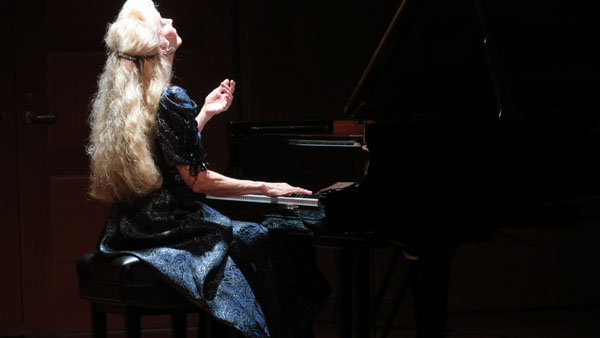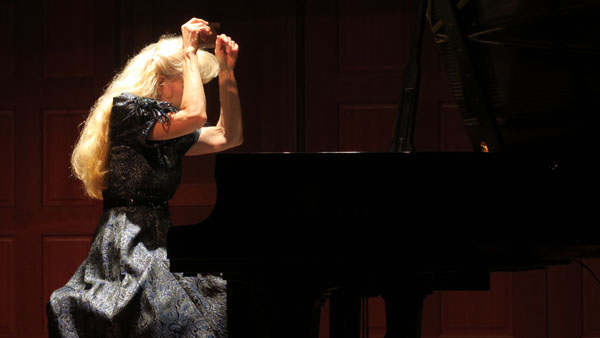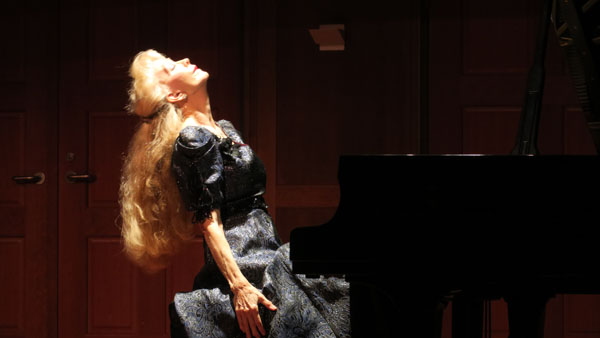“Walters captured the magic…” “Though no one tried to throw their underwear at her, Walters certainly held a similarly captivating stage presence as Liszt...” “An enriched musical experience…” “Meditative and reflective at moments and triumphant at others…”
“The Davidson College Music Department hosted internationally-renowned pianist Teresa Walters in recital on Sept. 22 in the intimate Sloan Music Center. Walters played her 2019-20 program “Celebrating Our World,” a selection of six pieces which she will be touring internationally. Walters emerged in a dazzling dark purple brocade gown with her long, platinum-blonde hair cascading down her back. Her dramatic presence introduced the opening piece, a dramatic Bach chaconne for violin, transcribed for piano by Ferruccio Busoni. The chaconne, written in the early 1700’s is the fifth and final movement of Bach’s partita No. 2 in D minor. The piece was incredibly moving, opening with moaning chords in grief and powerful strikes in rage and agony. A delightful piece by Spanish composer Enrique Granados entitled “The Maiden and the Nightingale,” lyrically describes an encounter between the two titled characters. A maiden expresses her love tragedies to a nightingale who listens and, at the very end, responds. Walters captured the magic between the two characters, especially in the brief message from the nightingale, with suppleness and delicacy. The remaining four pieces, split between the two halves of the program, were compositions by Franz Liszt. Liszt is Walters’s area of expertise – she is perhaps best known for her interpretations of the Hungarian composer, which have received nominations for the Grand Prix du Disque of the Hungarian Liszt Society, which recognizes international performers of the composer.
Liszt was a piano virtuoso, often considered the greatest pianist of his time. His reputation as a performer in his day could be likened to that of Elvis Presley. Liszt was handsome and charismatic, and it has even been rumored that women would throw their undergarments at him during performances, overtaken in a musical frenzy. Though no one tried to throw their underwear at her, Walters certainly held a similarly captivating stage presence; not only did she first appear in a sparkling evening gown, but after intermission reemerged in another elegant gown, this time in pink. Like Liszt, Walters clearly values appearance as a performance device. Though Liszt may be known initially for his wild, prodigious, and even scandalous shows, the composer was a complex character and, towards the end of his life, actually turned towards the church. Walters’s selections pointed more towards the religious Liszt rather than the showman, including Liszt’s lesser known “Hymn of Morning,” “Crusader’s March” and concluding with “The Canticle of the Sun of St. Francis of Assisi.” Throughout the performance, Walters delivered “Keynote Comments,” a series of prepared notes which were spoken in between the pieces, preparing the audience for the upcoming selection. These comments were informative and well-executed and made for an enriched musical experience. Especially nice was Walters’s recitation of St. Francis’ Canticle of the Sun- the prayer upon which Liszt’s piece is based. The piece, like the prayer, was meditative and reflective at moments and triumphant at others, such as at the beginning where St. Francis says “All praise is yours, all glory, all honor, and all blessings,” and Liszt mimics the declarative chords accented by brief, separating pauses, Walters was strongest in these final pieces, which also conclude her most recent album from this year, “A Liszt Celebration.” Walters has been called “The International First Lady of Piano” by The New York Times and acclaimed by numerous reviewers worldwide. It was a pleasure to hear a full piano recital – something rare, nowadays - and by such a renowned pianist. It was also a rare opportunity to hear multiple, lesser-known pieces by Liszt played on one program, and by a Liszt specialist, at that.”
|






